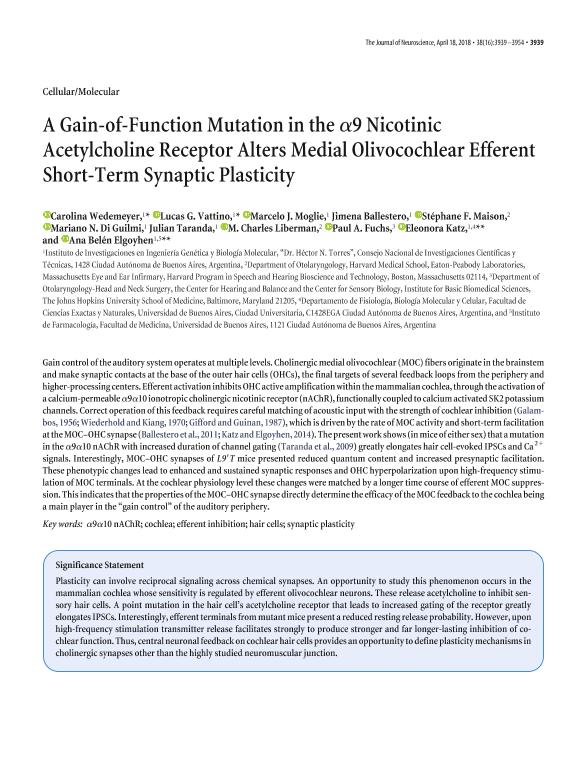Mostrar el registro sencillo del ítem
dc.contributor.author
Wedemeyer, Carolina

dc.contributor.author
Vattino, Lucas Gabriel

dc.contributor.author
Moglie, Marcelo Javier

dc.contributor.author
Ballestero, Jimena Andrea

dc.contributor.author
Maison, Stéphane F.
dc.contributor.author
Di Guilmi, Mariano Nicolás

dc.contributor.author
Taranda, Julian

dc.contributor.author
Liberman, M. Charles
dc.contributor.author
Fuchs, Paul A.
dc.contributor.author
Katz, Eleonora

dc.contributor.author
Elgoyhen, Ana Belen

dc.date.available
2019-07-18T19:02:13Z
dc.date.issued
2018-04
dc.identifier.citation
Wedemeyer, Carolina; Vattino, Lucas Gabriel; Moglie, Marcelo Javier; Ballestero, Jimena Andrea; Maison, Stéphane F.; et al.; A gain-of-function mutation in the α9 nicotinic acetylcholine receptor alters medial olivocochlear efferent short-term synaptic plasticity; Society for Neuroscience; Journal of Neuroscience; 38; 16; 4-2018; 3939-3954
dc.identifier.issn
0270-6474
dc.identifier.uri
http://hdl.handle.net/11336/79826
dc.description.abstract
Gain control of the auditory system operates at multiple levels. Cholinergic medial olivocochlear (MOC) fibers originate in the brainstem and make synaptic contacts at the base of the outer hair cells (OHCs), the final targets of several feedback loops from the periphery and higher-processing centers. Efferent activation inhibitsOHCactive amplification within the mammalian cochlea, through the activation of a calcium-permeable α 9 α 10 ionotropic cholinergic nicotinic receptor (nAChR), functionally coupled to calcium activated SK2 potassium channels. Correct operation of this feedback requires careful matching of acoustic input with the strength of cochlear inhibition (Galambos, 1956; Wiederhold and Kiang, 1970; Gifford and Guinan, 1987), which is driven by the rate of MOCactivity and short-term facilitation at theMOC-OHCsynapse (Ballestero et al., 2011; Katz and Elgoyhen, 2014). The present work shows (in mice of either sex) that a mutation in the α 9α 10 nAChR with increased duration of channel gating (Taranda et al., 2009) greatly elongates hair cell-evoked IPSCs and Ca2+signals. Interestingly, MOC–OHC synapses of L9’T mice presented reduced quantum content and increased presynaptic facilitation. These phenotypic changes lead to enhanced and sustained synaptic responses and OHC hyperpolarization upon high-frequency stimulation of MOC terminals. At the cochlear physiology level these changes were matched by a longer time course of efferent MOC suppression. This indicates that the properties of theMOC-OHCsynapse directly determine the efficacy of the MOCfeedback to the cochlea being a main player in the “gain control” of the auditory periphery.
dc.format
application/pdf
dc.language.iso
eng
dc.publisher
Society for Neuroscience

dc.rights
info:eu-repo/semantics/openAccess
dc.rights.uri
https://creativecommons.org/licenses/by-nc-sa/2.5/ar/
dc.subject
Cochlea
dc.subject
Efferent Inhibition
dc.subject
Hair Cells
dc.subject
Synaptic Plasticity
dc.subject
Α9α10 Nachr
dc.subject.classification
Neurociencias

dc.subject.classification
Medicina Básica

dc.subject.classification
CIENCIAS MÉDICAS Y DE LA SALUD

dc.title
A gain-of-function mutation in the α9 nicotinic acetylcholine receptor alters medial olivocochlear efferent short-term synaptic plasticity
dc.type
info:eu-repo/semantics/article
dc.type
info:ar-repo/semantics/artículo
dc.type
info:eu-repo/semantics/publishedVersion
dc.date.updated
2019-07-17T13:14:27Z
dc.journal.volume
38
dc.journal.number
16
dc.journal.pagination
3939-3954
dc.journal.pais
Estados Unidos

dc.journal.ciudad
Washington
dc.description.fil
Fil: Wedemeyer, Carolina. Consejo Nacional de Investigaciones Científicas y Técnicas. Instituto de Investigaciones en Ingeniería Genética y Biología Molecular "Dr. Héctor N. Torres"; Argentina
dc.description.fil
Fil: Vattino, Lucas Gabriel. Consejo Nacional de Investigaciones Científicas y Técnicas. Instituto de Investigaciones en Ingeniería Genética y Biología Molecular "Dr. Héctor N. Torres"; Argentina
dc.description.fil
Fil: Moglie, Marcelo Javier. Consejo Nacional de Investigaciones Científicas y Técnicas. Instituto de Investigaciones en Ingeniería Genética y Biología Molecular "Dr. Héctor N. Torres"; Argentina
dc.description.fil
Fil: Ballestero, Jimena Andrea. Consejo Nacional de Investigaciones Científicas y Técnicas. Instituto de Investigaciones en Ingeniería Genética y Biología Molecular "Dr. Héctor N. Torres"; Argentina
dc.description.fil
Fil: Maison, Stéphane F.. Harvard Medical School; Estados Unidos
dc.description.fil
Fil: Di Guilmi, Mariano Nicolás. Consejo Nacional de Investigaciones Científicas y Técnicas. Instituto de Investigaciones en Ingeniería Genética y Biología Molecular "Dr. Héctor N. Torres"; Argentina
dc.description.fil
Fil: Taranda, Julian. Consejo Nacional de Investigaciones Científicas y Técnicas. Instituto de Investigaciones en Ingeniería Genética y Biología Molecular "Dr. Héctor N. Torres"; Argentina
dc.description.fil
Fil: Liberman, M. Charles. Harvard Medical School; Estados Unidos
dc.description.fil
Fil: Fuchs, Paul A.. The Johns Hopkins University School of Medicine; Estados Unidos
dc.description.fil
Fil: Katz, Eleonora. Consejo Nacional de Investigaciones Científicas y Técnicas. Instituto de Investigaciones en Ingeniería Genética y Biología Molecular "Dr. Héctor N. Torres"; Argentina. Universidad de Buenos Aires. Facultad de Ciencias Exactas y Naturales. Departamento de Fisiología, Biología Molecular y Celular; Argentina
dc.description.fil
Fil: Elgoyhen, Ana Belen. Consejo Nacional de Investigaciones Científicas y Técnicas. Instituto de Investigaciones en Ingeniería Genética y Biología Molecular "Dr. Héctor N. Torres"; Argentina. Universidad de Buenos Aires. Facultad de Medicina; Argentina
dc.journal.title
Journal of Neuroscience

dc.relation.alternativeid
info:eu-repo/semantics/altIdentifier/url/https://www.ncbi.nlm.nih.gov/pmc/articles/pmid/29572431/
dc.relation.alternativeid
info:eu-repo/semantics/altIdentifier/doi/http://dx.doi.org/10.1523/JNEUROSCI.2528-17.2018
dc.relation.alternativeid
info:eu-repo/semantics/altIdentifier/url/https://www.jneurosci.org/content/38/16/3939
Archivos asociados
